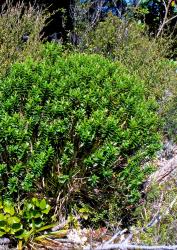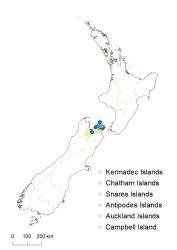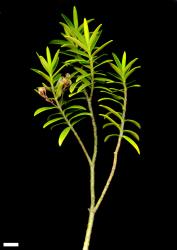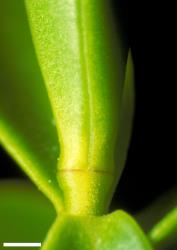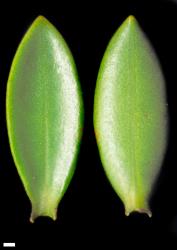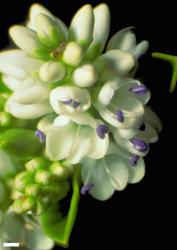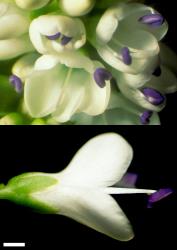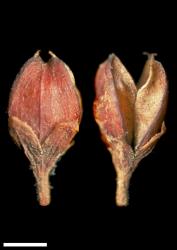- ≡ Hebe urvilleana W.R.B.Oliv., Rec. Domin. Mus. 1: 212 (1944)
Bushy shrub to 1.5 m tall. Stems usually erect, sometimes prostrate, eglandular-pubescent; hairs bifarious. Leaf bud distinct, its leaves appressed at margins until fully grown; sinus absent. Leaves opposite-decussate, erecto-patent to spreading; lamina coriaceous, elliptic or lanceolate to oblanceolate, 3–24 mm long, 2–8 mm wide, glossy green above, dull or glossy green beneath; midrib evident; surfaces glabrous or with eglandular hairs along midrib above; margin glabrous or minutely papillate, entire; apex sub-acute to acute, not or weakly plicate-acuminate; base cuneate; petiole indistinct, broadly winged, 1–2 mm long. Inflorescence a lateral raceme, 10–31 mm long; flowers crowded, 5–23, female or bisexual on separate plants, ⚥ ≥ ♀; bracts alternate, linear to elliptic, < or sometimes ≥ pedicels; pedicels erecto-patent, 1–4 mm long, eglandular-hairy all around, sometimes with minute glandular hairs as well. Calyx lobes 4, sub-acute to obtuse or rounded, 1.5–2.1 mm long, sub-equal, mixed glandular- and eglandular- ciliolate. Corolla 4–6 mm diameter; tube white, 1.8–2.2 mm long, > calyx, eglandular-hairy inside; lobes 4, white, erecto-patent to spreading, sub-equal or unequal, elliptic to broadly elliptic or orbicular, 2–3 mm long, obtuse or rounded, posterior sometimes emarginate, nectar guides absent. Stamen filaments white, 3.7–4.7 mm long; anthers magenta to purple. Style glabrous, 5–8 mm long. Capsule latiseptate, sub-acute to obtuse, glabrous, 2.5–5.3 mm long, 2.2–3.0 mm at widest point. Seeds not seen.
In their green, elliptic leaves and short inflorescences, V. urvilleana plants are very similar to plants of several other species, especially V. subalpina, V. treadwellii, V. rakaiensis, V. calcicola, and V. evenosa, none of which overlap in distribution with V. urvilleana.
V. subalpina and V. treadwellii plants are alpines with larger flowers and corolla lobes.
V. rakaiensis and V. calcicola plants can be distinguished by their hairy ovaries and fruits, and V. evenosa plants by their generally shorter leaves, which taper more abruptly at both base and apex, their longer inflorescences, and corolla tubes that are shorter than the calyx.
V. stenophylla var. oliveri plants, from nearby Stephens I. / Takepourewa and the Trio Is / Kuru Pongi, have similar leaves, but these differ in being less glossy and being conspicuously pitted near the margins above, and they have longer (2.5–3.8 mm) and usually glabrous corolla tubes. Usually their calyx cilia are all eglandular.
The chromosome number of V. urvilleana (2n = 120) is shared with V. evenosa, but with no other similar species.
South Island: Sounds Nelson (Rangitoto ki te Tonga / D’Urville I. and western Marlborough Sounds, extending to scattered localities in the Bryant Range).
Lowland to montane Leptospermum scrub and open shrubland. Recorded elevations range from 180 to 1220 m.
Flowers: January–February; fruits: February–April, persisting until November.
2n = 120 (see Bayly & Kellow 2006, as Hebe urvilleana).
Veronica urvilleana is classified in V. subg. Pseudoveronica sect. Hebe and the informal group “Occlusae” (Albach & Meudt 2010; Bayly & Kellow 2006). On the basis of ITS sequence data, V. urvilleana appears to be related to a large group of species characterised by small, green leaves, including V. evenosa, V. venustula, V. brachysiphon, and V. stenophylla, but its position is not well understood.



